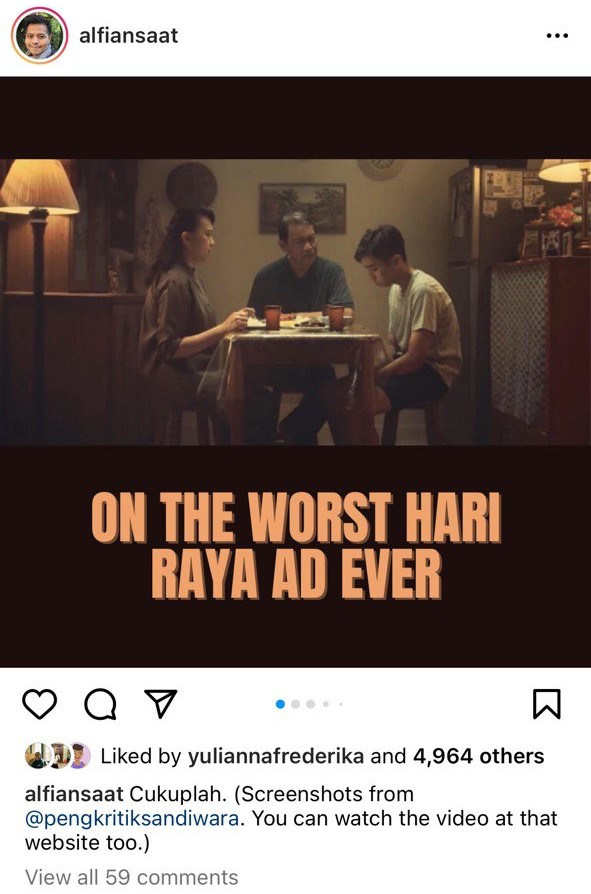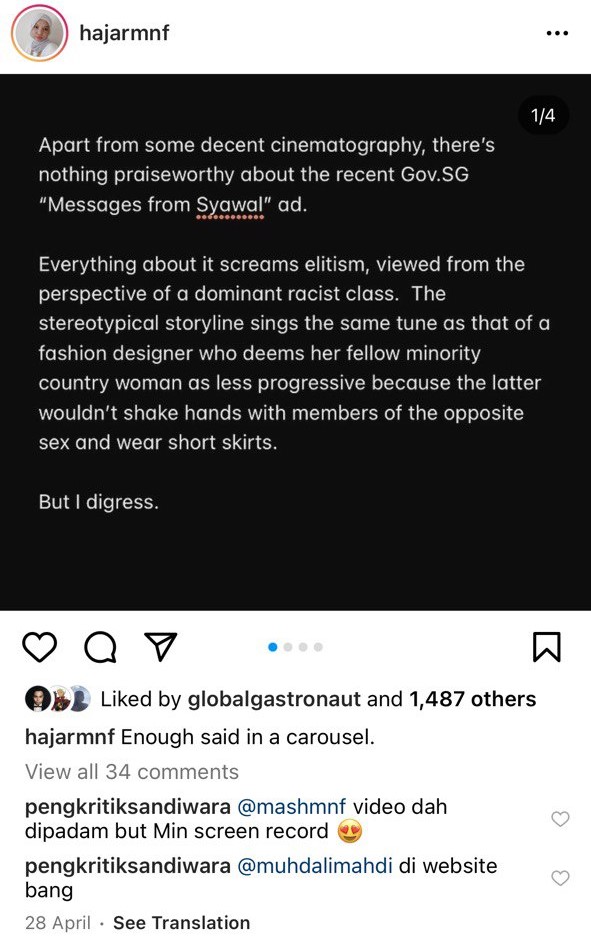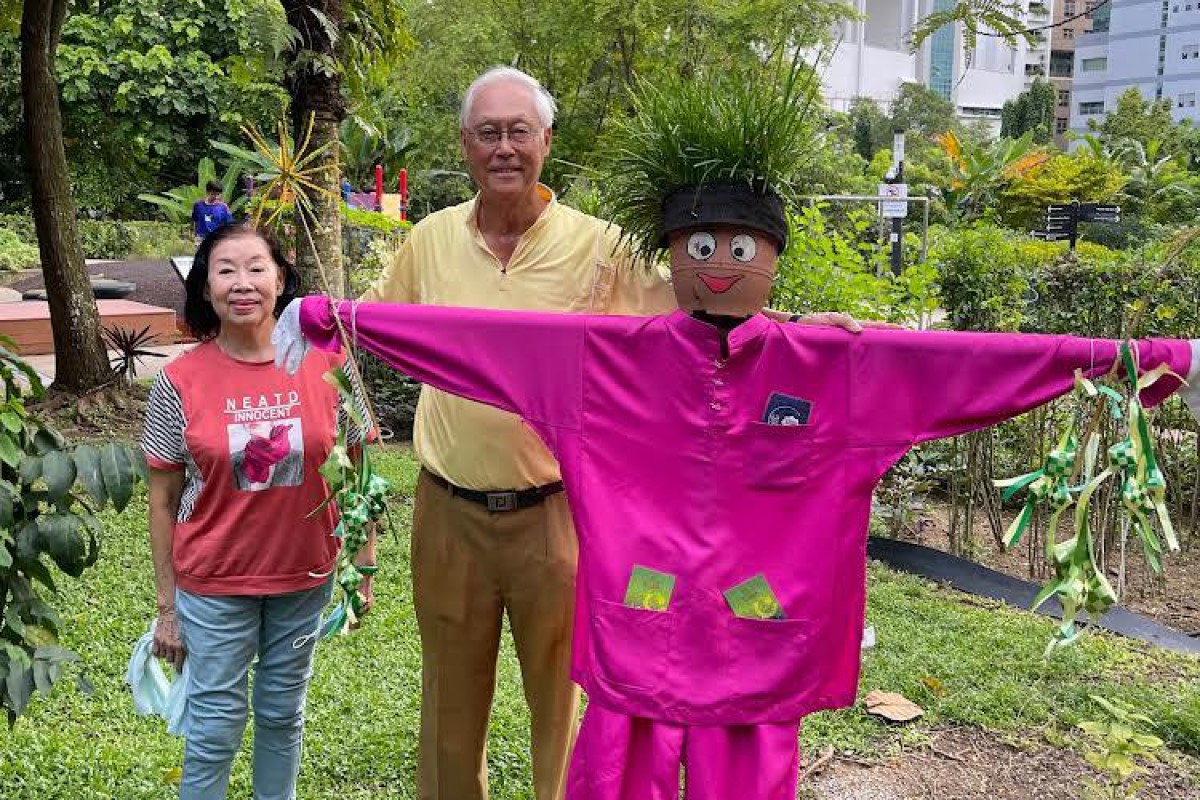Top image: Mparader
As I’m typing this at home on my phone, I’m surrounded by family and relatives, dressed to the sembilans in their new Hari Raya clothes. I have a large, close-knit family, all varied expressions of the Malay ethnicity.
My Javanese father is wearing a batik shirt. He cracks a joke with my mom, whose ancestors hail from Malacca. My Boyanese aunt asks where I got my delicious pineapple tarts, and because this is not sponsored content, I can only say that I bought them online.
We even have non-Malays in the mix. My wife is Chinese-Indian; her Chinese mother is here too, gushing to my brother’s Chinese-Indonesian wife about her pregnancy. My cousin tells me about her new job while her Chinese husband sings their newborn to sleep in my bedroom.
Another cousin of Indian descent pops over after a while to discuss our favourite Netflix shows. Her British Caucasian husband joins us shortly afterwards, a paper plate of ketupat and rendang in hand.
The lingua franca here is mainly English, a conscious practice on all our parts because we don’t want anyone to feel out of place, with no inroads into any of the merriment because of a linguistic barrier.
This is our reality because we learnt not to let the colour of a person’s skin blind us to the contents of their character. And it is especially ingrained into our beings because all of us, in one form or another, have experienced discrimination for being Malay.
We have been made to feel inferior many times for the colour of our skin, such as when we learnt that more than one in four of our Chinese fellow Singaporeans would not be able to accept a Malay Prime Minister.
So we accept, love, include, and unite because we’ve learnt not to expect others to do it for us.
Against this backdrop, my cousin asks, “Did you see that gov.sg Raya video?”
What was wrong with the video?
And involuntarily, I cringed. I had seen it, thought poorly of its premise, and hoped the screenwriter would get better in the future. As a screenwriter myself, I see a lot of videos that mean well but execute their benevolent intentions very poorly.
If you haven’t seen the video, it featured a boy named Syawal (a little on the nose since Hari Raya falls on the first day of the Muslim month of Syawal), whose family isn’t exactly in the best of circumstances. His dad works as a mover, and his mother is a housewife—the three live in a rental flat.
With their precarious financial situation, Syawal skips school to work distributing flyers. The parents are unaware of this until Syawal’s teacher pays them a visit. This galvanises the parents into action: the mother returns to work while the father, with help from SkillsFuture, finds a new, presumably better-paying job. Syawal goes back to school. In the end, the family move into a new home of their own, where they celebrate Hari Raya.
It’s since been taken down, but enough people had already seen it.
To give credit where it is due, the video is heartwarming and was well-produced and directed. The performances were effective in hitting the emotional beats of the video. But there is so much that’s also fundamentally wrong with it.
Firstly, it breaks a rule I’ve learnt to apply when working with government agencies or brands with a deep public interest. I call it the All Or Middle rule.
Basically, the rule states that if you need to depict a particular group of people or community, you either show enough members of that community such that it is representative of its whole, or you take the middle or median example of that community.
So if, say, family income is central to the narrative of your video, show a family whose lifestyle and livelihood are aligned with what the middle tier of that community looks like. Or, you show multiple families who are representative of the entire spectrum of that community.
To be fair, I think the fact that it came from the Ministry of Communications and Information and was placed on the gov.sg portal added to the problem. If the video had come instead from Jamiyah or Pertapis, I think the backlash wouldn’t have been this pronounced.

The intentional lack of agency on show
The video also suggests that being lower middle class is undignified, that it’s only with homeownership and improved employment that a family can be happy and/or celebrate Hari Raya.
The next problem with the video is that Syawal’s family are shown to lack agency, meaning the ability and desire to act with or exert power—in this case, over their own financial situation and lives. There are no scenes that show Syawal’s family empowered and taking their destinies into their own hands.
The only one who showed any agency was Syawal—he chose to skip school to earn some extra cash. Any other depiction of agency was glossed over or happened off-screen.
Instead, their destinies are put into motion by external forces. It is with SkillsFuture that Syawal’s father can land a more stable job (we do not even see a scene where he, on his own accord, at his own impetus, decides to do this for himself or his family).
It was after Syawal’s teacher’s intervention that his parents realised they perhaps needed to find extra income. It took a government policy and a civil servant for this Malay family to improve their lives. Their son’s foray into the private sector was depicted as unbecoming. Of course, this was probably never the MCI’s intention. But you see where it might be misinterpreted.
Compare this to gov.sg’s Chinese New Year video for this year. The Chinese family was shown to have agency, to be able to make decisions for themselves. Who goes onto the invite list in this pandemic New Year? Which uncle must we not offend? It’s fun, current, relatable, and most importantly, we see the family having agency.
Heck, compare it to gov.sg’s Hari Raya 2021 video! That one was very well done—a large family, working together, helping others. It was light-hearted, informative, and followed the All Or Middle rule.
Goh Chok Tong and the Not-Scarecrow of Hari Raya
My discussion with my cousin then turned to our former Prime Minister, Mr Goh Chok Tong’s Hari Raya Instagram post.
Not many people appreciated it.
Now, look, Mr Goh is not perfect. If I were to start a reggae band, for example, I would not have him as lead singer—even if we miss out on the awesome band name of Chok Tong and The Gah-men.
But I do believe he had published that post without the intention of portraying Malay people as scarecrows, even though, without the context of his work in building a “progressive, metropolitan Singapore”, it is not a stretch to make that assumption, considering the makeup of the Malay effigy, and its placement in a garden.
It was probably meant to show Mr Goh keeping active—gardening, a clear association between the man and the garden city he helped build. It’s a nice, heartwarming image, like seeing our favourite grandpa treating ageing like it ain’t no thang.
Combining that with a Hari Raya message is also a nice gesture, almost like he took time out of his favourite hobby to tip his gardener’s hat to us and wish us Selamat Hari Raya.
But it’s in creating a representation of Malay people with garden paraphernalia squeezed into baju Melayu that Mr Goh’s post went wrong. It’s as if—and I understand that this was never his intention—he had reduced Hari Raya to the baju Melayu and not the triumphant celebration of a people who had persevered through an entire month in Ramadan.
A for effort and creativity, definitely, but not quite the best communications idea for Hari Raya.
The Malay people are, and I shouldn’t have to say this, a people. The best way to portray Malay people is with Malay people. There are very few acceptable alternatives. A cute drawing by a child, perhaps. A painting by an artist, preferably Malay. Madame Tussaud’s wax figurine of Fandi Ahmad.
Perplexingly, this post is by a man who held the greatest office in our land, so I am sure he has access to Malay people.
Mr Goh eventually goes on to defend his post.
But I don’t think he quite understood what was really wrong with it in the first place. The scarecrow misinterpretation barely touches the core of the problem.
So let’s get to the core
There are two truths in Singapore about race.
One is that we undoubtedly enjoy a level of racial harmony and diversity you can hardly find anywhere else. Second, racism still exists here. Yes, it is not as systemic or damaging as it is in other advanced nations. But there’s a reason why race is a touchy subject. That tension did not arise ex nihilo.
In particular, public discourse on the Malay community in Singapore has been somewhat problematic. Even when there is no blatant racism, it recognises the Malay people as lagging behind the rest of the nation.
As reported in the book Lee Kuan Yew: The Man And His Ideas, our own founding father said of Malay people, “We must remember that in Singapore, the Malays feel they are being asked to compete unfairly, that they are not ready for the competition against the Chinese and the Indians and the Eurasians. They will not admit, or they cannot admit to themselves that, in fact, as a result of history, they are a different gene pool, and they do not have these qualities that can enable them to enter the same race.”
This, of course, was said decades ago, in the pre-woke, freshly post-colonial years. But it would be fair to say that it was instrumental in moulding the public’s perception of Malay people across the multiple generations that Mr Lee guided the nation.
Perhaps what was said by Mr Lee had some truth, based on his personal observations. But as the Malay people found their footing in Singapore and took strides towards progress, we didn’t just have to compete against the other races. We instead had to fight ingrained perceptions of our race.
We had to keep pushing against a lower socioeconomic ceiling due to historically having lower social and financial capital. We had to constantly prove to people—our leaders especially—that we could balance being Singaporean with being Muslim and our affinity towards our fellow Malays across the Nusantara.
So when you show a Malay family-like Syawal’s, know that it’s been done to death. Know that it does not consider—and instead adds to—the psychological heavy lifting (in relation to how we are talked about in public discourse) Malay people do on a day-to-day basis.
It needs to show our progress because for too long, we are measured by how far behind we are. The Malay people have had to contend with both racism and elitism, all the while still striving for unity, cooperation and harmony.
I’m very sure Mr Goh is keenly aware of all this. But he does not live the experience of the Malay community. We do. And when we see a post like his or the gov.sg video, we see a history of Malay people being presented in the media or public communications as the group bringing up the rear.
Still, the most important lesson here is to ask a neutral Malay person before you start work on any public communications about the Malay community. I’m sure Malay people were involved in the gov.sg Hari Raya video production. But sometimes, it’s hard to be objective when you’re in the thick of it or when the creation of the video is integral to your livelihood.
I honestly don’t blame them for not saying anything. The system of checks and balances within the MCI and gov.sg should have done better.
In the immortal words of the West Coast bard O’Shea Jackson, “chickity check yo’self before you wreck yo’self”.

Doing better today
I know I might sound angry, but please don’t get me wrong. I love my country. It has done a lot for me.
I am a bestselling author and writer, earning a living from stringing together sentences in a language spoken by over 1.5 billion people—a language brought to us by our former colonial overlords.
This article I’m writing can be easily accessed by anyone within seconds. I’ll be showing it off to my friends through my phone—a highly advanced computer that I keep in my pocket. I’ve gone beyond my ancestors’ wildest dreams in nearly every count. All this is made possible because I am a Singaporean in Singapore in the 21st century.
And yet, there’s racism still. We are starting to have a clear idea of where it comes from. It might be ingrained, psychological, accidental or due to a lack of oversight.
In this instance, Mr Goh was right: racial harmony is always a work in progress. Let’s make sure we put in the work and make sure the work is geared towards progress.
Ultimately, I do not conflate this video with the Ministry of Communications and Information as a whole. As a media practitioner myself, I see the great work it puts in for the people of Singapore in a communications landscape that is rapidly evolving.
I also do not conflate Mr Goh Chok Tong and his great legacy with that one post. But that’s me. There are people, fellow Singaporeans of all ages, whose mental wellness, self-identity and sense of self-worth are not quite insulated from messaging like these.
Worse, some might use messaging like these to reinforce their negative perceptions of Malay people.
Let’s also think of our future—the younger members of our society. Their ideas of social hierarchy, their place in society, the values and underlying truths of our nation, of their respective socioeconomic ceilings will be formed by how the media depicts the people they relate to the most.
So, for our own sake, let’s do better. No human endeavour, including Singapore’s exercise in nationhood, is perfect and without fault. But if we learn to truly respect one another and work together, we can go further than we’ve ever imagined.



